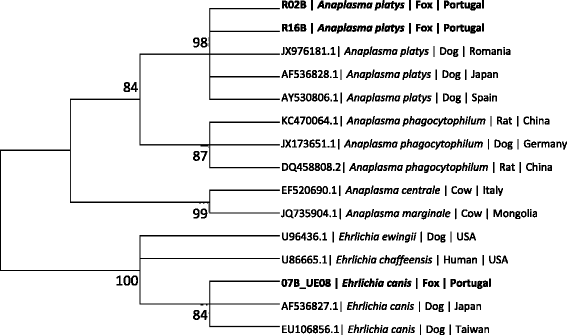First report of Anaplasma platys infection in red foxes (Vulpes vulpes) and molecular detection of Ehrlichia canis and Leishmania infantum in foxes from Portugal
- PMID: 25889750
- PMCID: PMC4369893
- DOI: 10.1186/s13071-015-0756-y
First report of Anaplasma platys infection in red foxes (Vulpes vulpes) and molecular detection of Ehrlichia canis and Leishmania infantum in foxes from Portugal
Abstract
Background: The bacteria Anaplasma platys and Ehrlichia canis and the protozoan Leishmania infantum are vector-borne agents that cause canine vector-borne diseases, some of which are zoonotic. The present survey investigated the prevalence of Anaplasma, Ehrlichia and Leishmania in red foxes (Vulpes vulpes) from Portugal by molecular analysis, in order to evaluate the epidemiological role of these canids as reservoirs of infection.
Methods: Blood and/or bone marrow samples were collected from 78 red foxes obtained in eight districts of northern, central and southern Portugal. Real-time polymerase chain reactions (PCR) amplified a 123 bp fragment of the 16S rRNA gene of Anaplasma spp. and Ehrlichia spp. and a 265 bp fragment of the L. infantum internal transcribed spacer one (ITS1) region of the rRNA operon evaluated by PCR-high resolution melt analysis (PCR-HRM), with sequencing of the DNA products. A phylogenetic analysis was carried out to compare these to other sequences from Anaplasma spp. and Ehrlichia spp. deposited in GenBank.
Results: A. platys was detected in 10 (14.5%) and E. canis in two (2.9%) out of 69 foxes; and L. infantum was detected in one (1.3%) of the 78 foxes. The prevalence of A. platys was significantly different from the prevalence of E. canis (p=0.016) and from that of L. infantum (p=0.002). No co-infections were found in any one of the 78 foxes. No statistically significant differences were found between the type of sample (blood and bone marrow), geographic regions (north/centre and south), age (<2 years and ≥2 years) and gender for any one of the agents.
Conclusions: This is the first known report of A. platys in red foxes worldwide, as well as the first molecular evidence of E. canis in foxes from Portugal. The moderate prevalence of A. platys suggests that red foxes may play a role in the epidemiology of infection with this bacterium and serve as a reservoir for domestic dogs.
Figures

Similar articles
-
Molecular identification and characterization of Anaplasma platys and Ehrlichia canis in dogs in Mexico.Ticks Tick Borne Dis. 2016 Mar;7(2):276-83. doi: 10.1016/j.ttbdis.2015.11.002. Epub 2015 Nov 12. Ticks Tick Borne Dis. 2016. PMID: 26615872
-
Association between canine leishmaniosis and Ehrlichia canis co-infection: a prospective case-control study.Parasit Vectors. 2018 Mar 20;11(1):184. doi: 10.1186/s13071-018-2717-8. Parasit Vectors. 2018. PMID: 29554932 Free PMC article.
-
High serological and molecular prevalence of Ehrlichia canis and other vector-borne pathogens in dogs from Boa Vista Island, Cape Verde.Parasit Vectors. 2024 Sep 4;17(1):374. doi: 10.1186/s13071-024-06437-9. Parasit Vectors. 2024. PMID: 39232789 Free PMC article.
-
Co-infections of rickettsiales in clinically healthy, Leishmania infantum seropositive and seronegative dogs: a systematic literature review and new findings from Southern Italy.Parasitol Res. 2025 Jan 29;124(2):14. doi: 10.1007/s00436-025-08458-4. Parasitol Res. 2025. PMID: 39878800 Free PMC article.
-
Geographic distribution and spatial analysis of Leishmania infantum infection in domestic and wild animal reservoir hosts of zoonotic visceral leishmaniasis in Iran: A systematic review.J Vector Borne Dis. 2018 Jul-Sep;55(3):173-183. doi: 10.4103/0972-9062.249125. J Vector Borne Dis. 2018. PMID: 30618442
Cited by
-
The Eurasian otter (Lutra lutra) as a potential host for rickettsial pathogens in southern Italy.PLoS One. 2017 Mar 7;12(3):e0173556. doi: 10.1371/journal.pone.0173556. eCollection 2017. PLoS One. 2017. PMID: 28267780 Free PMC article.
-
Molecular survey of Ehrlichia canis and Coxiella burnetii infections in wild mammals of southern Italy.Parasitol Res. 2016 Nov;115(11):4427-4431. doi: 10.1007/s00436-016-5213-0. Epub 2016 Aug 17. Parasitol Res. 2016. PMID: 27535678
-
Seroprevalence of vector-borne pathogens and molecular detection of Borrelia afzelii in military dogs from Portugal.Parasit Vectors. 2016 May 10;9(1):225. doi: 10.1186/s13071-016-1509-2. Parasit Vectors. 2016. PMID: 27160284 Free PMC article.
-
Arthropod-Borne Pathogens in Wild Canids.Vet Sci. 2023 Feb 19;10(2):165. doi: 10.3390/vetsci10020165. Vet Sci. 2023. PMID: 36851469 Free PMC article. Review.
-
First molecular evidence of Anaplasma platys infection in a dog (Labrador retriever) from Bulgaria.Open Vet J. 2024 Dec;14(12):3656-3664. doi: 10.5455/OVJ.2024.v14.i12.47. Epub 2024 Dec 31. Open Vet J. 2024. PMID: 39927347 Free PMC article.
References
-
- Alleman AR, Wamsley HL. An update on anaplasmosis in dogs. Vet Med. 2008;103:212–20.
MeSH terms
Substances
LinkOut - more resources
Full Text Sources
Other Literature Sources
Molecular Biology Databases
Miscellaneous

